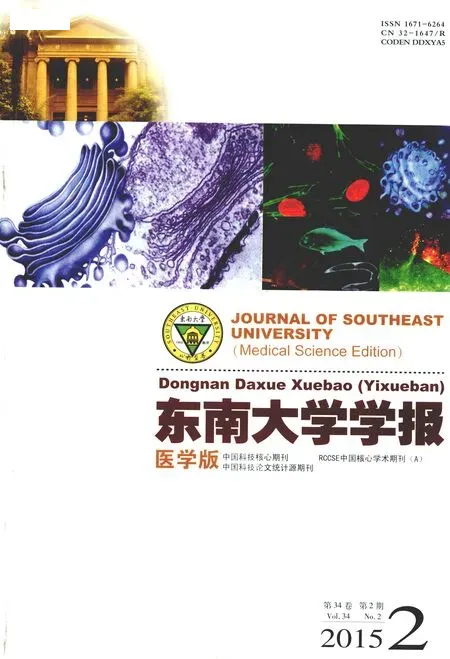1 General Diagnosis
2015-03-22
1 General Diagnosis
2015131 Reactive oxygen metabolites measurement,establishment of a new method and its performance evaluation.YANG Ting(杨汀),et al.Dept Respir& Critical Med Care,Beijing Chaoyang Hosp,Capital Med Univ,Beijing 100020.Chin J Lab Med 2015;38(3):163-167.
Objective To establish a simple,cost-effective method to measure reactive oxygen metabolites(ROMs)using automatic biochemical analyzer.Methods Serum samples were collected from 50 healthy individuals and 50 hospitalized patients in Beijing Hospital from September 2013 to November 2013.By setting up and optimizing parameters on automatic biochemical analyzer,a new method of measuring ROMS was established with TBHP as calibrator.130 healthy non-smokers were recruited in Beijing Hospital from November 2013 to December 2013 to establish reference interval,including 73 males and 57 females.The average age was 68.8± 12.5.According to CLSI documents,the new method regarding precision,limit of blank(LoB),limit of detection(LoD),limit of quantitation(LoQ),linearity,interference testing,and reference interval was established.Results The intra assay imprecision was 1.5%-4.1%and the total imprecision was 4.4%-9.9%.LoB was 0.85 mmol/L TBHP;LoD was 2.7 mmol/L TBHP;LoQ was 5.9 mmol/L TBHP.The linearity was 5.9-600 mmol/L(R2=0.995).When triglyceride≤28.58 mmol/L,hemoglobin≤173 g/L,vitamin C≤60 mg/dl and bilirubin≤73.8 μmol/L,the deviation was-7.6%,4.6%,-98.9%,19.1%respectively.The normal reference interval was 61.9-88.1 mmol/L TBHP. Conclusion The newly-established method has good performance of precision,LOD and linearity,which can meet the clinical needs.The interference of triglyceride and hemoglobin is small,while vitamin C and bilirubin have stronger interference on measurement.
(Authors)
2015132 Evaluation of an automated morphological analysis system in white blood cell identification. WANG Geng(王庚),et al.Dept Lab Med,PUMC& CAMS,Beijing 100730.Chin J Lab Med 2015;38(3):168-172.
Objective To evaluate the clinical performance of an automated image analysis systems named Cella Vision DM96 in classifying white blood cells.Methods A total of 2267 peripheral blood samples(male 1 235,female 1 034,average age 46)were obtained from outpatient and inpatient in Peking Union Medical College Hospital (PUMCH).These samples were selected to evaluate the precision,sensitivity,specificity and the analytical error of the system.We first evaluated the coincidence rate of reclassification and manual microscopy.On the base of favourable coincidence rate,we then evaluated the correlations between the pre-classification and reclassification of segmented neutrophil,band neutrophil,lymphocyte,monocyte,eosinophile,basophile,blast cell,promyelocyte,myelocyte,metamyelocyte,plasma cell and reactive lymphocyte.Results The sensitivity and specificity of pre-classification of white blood cell were 36%-100%and 24%-92%,respectively.When studied on the cell level,the total coincidence rate of pre-classification was 88%.And the coincidence rates of pre-classification and reclassification of white blood cell were 6%-95%and 25%-100%,respectively.When assessed on the sample level,the coincidence rates of pre-classification and reclassification of leukocytes were 64%-98% and 84%-100%,respectively.The correlations of preclassification and reclassification of leukocytes in the order of high to low were:lymphocyte,segmented neutrophil,eosinophile,band neutrophil,monocyte,basophile,when r was 0.943 9,0.915 2,0.785 4,0.775 6,0.676 2 and 0.289 1,respectively.The correlations between reclassification and manual microscopy of white blood cell were higher than those between preclassification and manual microscopy.The order from high to low was:eosinophile,segmented neutrophil,lymphocyte,monocyte,band neutrophil,basophile.And r was 0.972 1,0.968 5,0.9575 0,0.831 9,0.800 6 and 0.648 7,respectively.The ability of this automated image analysis systems at pre-classification in distinguishing band cell and segment cell, atypical lymphocyte and nor-mal lymphocyte was not good.Conclusion The performance of reclassification was better than pre-classification. The reclassification can be a substitute for the microscopy inspection,and be used in the clinical practice.
(Authors)
2015133 Quantitative study on locations of calcification in spherical lesions.WANG Qiuping(王秋萍),et al. Dept Radiol,1st Affil Hosp,Xi'an Jiaotong Univ,Xi'an 710061.Chin J Radiol 2015;49(4):264-267.
Objective To study feasibility of differentiation of benign and malignant by using eccentric rate of calcification in pulmonary spherical lesions.Methods Two hundred and forty cases with pulmonary spherical lesions (malignant in 170 and benign in 70)confirmed by pathology or clinical follow-up were collected in this study. All cases were undergone chest CT examinations.Nodule CAD software was used to demarcate pulmonary spherical lesions and internal calcification.Calcification was defined as an area more than 3 pixel with calcification density(CT value>120 HU).Furthermore,the ratio of calcification center distance and calcification edge distance was calculated as Ecc.Mann-Whitney U test was used to compare the eccentric calcification rates between the malignant and the benign pulmonary spherical lesions.Taking pathological results as golden standard,the diagnostic efficacy of Ecc was analyzed using ROC curves.Results In 240 lesions,65 calcifications were detected,of which 18 were malignant calcification distributed in 10 lesions,and 47 were benign calcifications distributed in 16 lesions.The median of Ecc in benign and malignant lesions was 0.80(0.28-1.29)and 3.01(1.52-4.47).The Ecc of calcification in benign lesions was lower than that in malignant lesions(U=183.000,P<0.01).Under the cut-off value of 1.00,benign calcifications were more likely to lie in inner 1/2 part of lesion [61.70%(29/47)],while malignant calcifications were more likely to lie in outer 1/2 part of lesion[77.78% (14/18)].The difference was statistically significant (χ2=8.117,P<0.01).Under the cut-off value of 1.72,the resultant sensitivity,specificity,accurate rate were 83.1%,77.8%,81.5%respectively.The area under the ROC was 0.804.Conclusion Ecc exhibits the location characteristics of calcification and may be an ideal parameter in quantitative diagnostic modeling for providing evidence of quantitative diagnosis.
(Authors)
2015134 Three-dimensional computerized quantification for lung invasive adenocarcinoma with different histopathological subtypes in clinical stageⅠ. ZHANG Li(张丽),et al.Dept Diag Radiol,Cancer Hosp,CAMS&PUMC,Beijing 100021.Chin J Radiol 2015;49(4):268-272.
Objective To study three-dimensional computerized quantification for clinical stageⅠ lung invasive adenocarcinomawithdifferenthistopathologicalsubtypes. Methods Pathological and HRCT data of 273 patients within clinical stageⅠlung invasive adenocarcinoma undergoing surgery from January 2005 to December 2012 were retrospectively collected.The proportion of ground glass opacity component and solid component in tumor was calculated by three-dimensional computerized quantification.All specimens were classified into 3 grades (grade 1 as the lepidic pattern of invasive adenocarcinoma,grade 2 acinar or papillary patterns,grade 3 micropapillary or solid patterns).The proportion of different components among different histopathological grades was evaluated by Kruskal-Wallis test.The correlation between components in tumor and histopathologic subtypes grade were evaluated by Spearman correlation.Results In 273 patients,49(17.9%)were assessed as grade 1,208 (76.2%)grade 2,and 16(5.9%)grade 3.The proportion of ground glass opacity component and solid component in grade 1,grade 2,and grade 3 were 18.40% (10.00%-33.45%),6.55%(2.00%-18.00%),1.70%(0.20%-3.85%)and 29.80%(11.75%-47.35%),66.60%(35.40%-83.85%),88.50% (75.28%-93.60%),respectively.Significant differences among different histopathological grades were observed(χ2=37.74,47.73,P<0.01).The proportion of ground glass opacity component was negatively correlated with histopathologic grade(r=-0.37,P<0.01),while the proportion of solid component was po sitivelycorrelated with histopathologic grade(r=0.42,P<0.01).ConclusionThree-dimensionalcomputerized quantification for lung invasive adenocarcinoma can predict histopathological grade.
(Authors)
